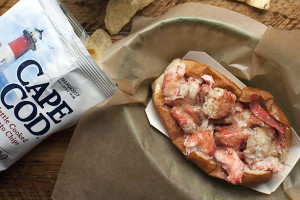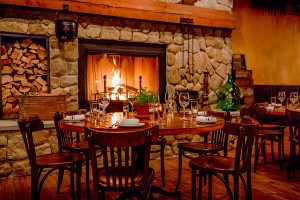Dining Out: Mucho Gusto
“It's the South End in Roslindale,” my friend Gus the Boulevardier told me about Gusto, the simple Italian restaurant in a very pleasant neighborhood I find myself increasingly drawn to. Roslindale Square is becoming more and more interesting for the urban food-lover, reminiscent of the Watertown stretch of Mt. Auburn Street, that paradisal passage where some of the city's best produce markets and irresistible Armenian and Lebanese markets and bakeries are interspersed with fledgling Anglo restaurants and food shops. And like Watertown, Roslindale has fine dining for nearby residents who like a good bowl of pasta but don't feel like getting dressed up and spending a lot of money. In Watertown, it's Stellina; in Roslindale, it's Gusto.
Some of the many Roslindale residents who have adopted Gusto since it opened a year and a half ago—ensuring a line every weekend and keeping it crowded on weeknights—might take umbrage at the description Gus suggests. But I think he's right. There's every reason to think that Gusto evokes the South End. After all, owners Tom Hall and John Bellott carved out the South End's niche as a dining destination when they opened Icarus in 1979, making the neighborhood safe for Hamersley's Bistro and the other trendsetting restaurants that followed.
A few years ago, Hall and Bellott moved from the South End to Roslindale and decided to move their business too. (“You can't believe the hassle I went through with valet parking,” Bellott told me while reciting the list of reasons they pulled out.) They knew they would take to their new address their skill at creating a welcoming, easygoing space and atmosphere. And this time they knew there would be plenty of parking on Washington Street (it's a mile from the Forest Hills T and the Roslindale Village train station, next to Boschetto Bakery, which has the best Dolce Vita-evoking electric sign in Boston).
What they didn't know was who would cook. Hall, a designer and woodworker, had been responsible for the stripped-wood look and art-nouveau stained-glass windows at Icarus, so the construction and design was taken care of. Bellott kept the books and warmly greeted guests at Icarus and would do the same at the new place. But even though the two were the very first cooks at Icarus, and Bellott still kept his hand in with his prize chocolate mousse cake, they needed a kindred spirit to guide the kitchen. They found it in Jim Mercer, who had worked at the caterer East Meets West during its “hot years,” as he put it to me, when South End style was threatening to conquer not only the city, but the state.
True to its new neighborhood, Gusto is more comfortable than chic, with warm ocher walls adorned with color photos of Italian locales, giving the place a homemade look. The food tastes homemade, too, in a way I like. There's hardly any preciousness to it. It's not terribly Italian, either, even if Bellott told everyone this was the pasta joint he'd always wanted. Mercer isn't Italian; he ran a Mexican restaurant for a while, and East Meets West was more French-Asian than anything else. But he has taken the best possible lesson from Italian cuisine: Find the best produce you can and get out of its way.
The eggplant compote on an ample vegetarian antipasto plate ($10.50) tastes both smoky, from the deeply charred eggplant (somehow the kitchen doesn't leave a fleck of black skin, a skill I envy), and sweetly fresh, a feat I remember from no other baba ghanoush-style eggplant I've ever tasted. A romesco-style sauce has deep tomato flavor from fresh and sun-dried tomatoes, and a spreadable consistency from a bread-crumb thickening. A wedge of baked polenta with gorgonzola and walnuts ($8.50) is nearly rich enough to be a main course. Like many of the appetizers and a few of the main courses, unfortunately, it suffers from too much salt, in this case from a very salty cheese. Mercer isn't afraid of garlic or red pepper, either, but he uses them only as judicious jabs of flavor.
The dish that sold me was tri-color tortellini with spring vegetables and carrot basil sauce ($15). “I finally took a stab at making something I would like as a vegetarian dish,” Mercer told me, admitting he has always thought that meals without meat or fish lack something. This doesn't. I haven't had sautéed vegetable chunks so clearly differentiated, each one lightly browned and tender without being mushy, since the last time I was in Italy. I was sure that there were both cream and tomatoes in the sauce, but Mercer told me the base was simply carrots cooked to the char point, puréed, and mixed with pesto and fresh garlic. He buys the plump and fresh, cheese-filled tortellini from the top-quality purveyor Capone Foods, in Somerville. I'm keeping tabs on this as vegetarian dish of the year.
The simplest main courses were the best. A cornmeal-crusted rainbow trout ($17.50) was the biggest trout I'd seen in a while, obviously the top of the fish-farm line (all restaurant trout in this country are farmed), with a crisp and very light cornmeal dusting, and sweet and tender meat. The sauce tastes more complex than the plain pan-juice deglazing Mercer told me it is, with just white wine, balsamic vinegar, and capers. My guest would hardly let me near the wilted frisée—she had never tasted quickly sautéed bitter chicory, and practically semaphored the cooks in the open kitchen to come tell her how to make it. This is exactly the kind of dinner you'd make at home if you had the time to find the ingredients and the skill to know when to stop.
The texture of the roasted monkfish ($17.50) was a bit less sure, perhaps because the chunk was so thick, and the pan-seared scallops with Capone's chive gnocchi ($18.50) were too white, bearing little evidence of searing. The gnocchi was a bit gummy; pasta is evidently Capone's strong suit. Grilled chicken with whole roasted garlic, potatoes, and carrots ($16.50) returned to Mercer's own strong suit: long cooking, whether braising or roasting. This was perfectly done with desirable buckled and blackened skin and meat cooked through to the bone (too infrequently done these days, when restaurants cook roast chicken to order but not long enough) so you can't resist picking up the pieces to gnaw on them.
It's those vegetables that will bring me back. Several dishes were generously festooned with fresh-shucked peas, bright green and fast sautéed to retain sweetness. Any kitchen that takes the time to shell what must have been a mountain of peas to share the seasonal bounty with as many diners as possible is the kind of generous kitchen I like. Mercer buys local too—the very good, marvelously crusty baguettes from Fornax, which also supplies Gusto with pizza dough that it bakes into nightly focaccias to serve hot and fresh. Mercer excitedly told me about the “best heirloom tomatoes” he's ever had, from a farm truck delivering to Jamaica Plain's Harvest Co-operative Supermarket. He's reserved a summer supply.
Bellott chose the wine list for value, and almost all bottles are $20 to $30. A Principessa Gavi ($25) is a refreshing Sancerre equivalent to go with the summer menu, and a Prunotto 1998 Barbera d'Asti ($30) is just the right counterbalance to Mercer's judicious but sharp main-course flavorings. Bellott still makes his own chocolate mousse cake, seemingly light and very satisfying, which he calls torta cioccolata (all desserts are $5.50). That's the best of the four I tried. He's working on his skills as a pastry chef, he told me, and in the expansion he and Hall are already building, he'll have a whole kitchen area of his own. There will be more seats, as well as outdoor dining, a wine bar, and finally a waiting area where locals can eye outsiders with annoyance.
They'll be justified in wanting it to themselves. Gusto is a local gem.


